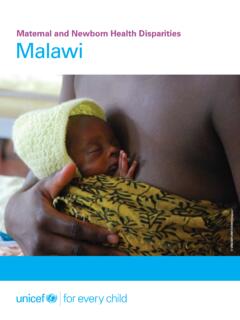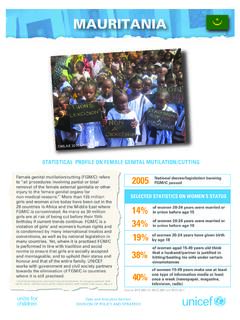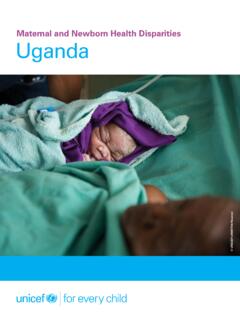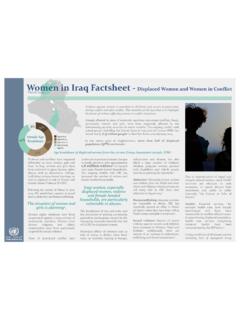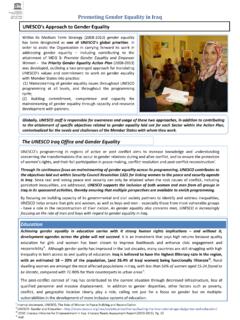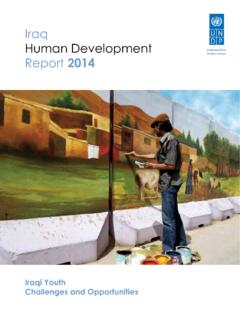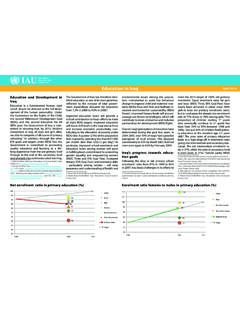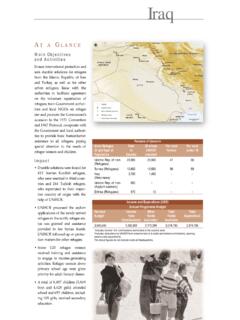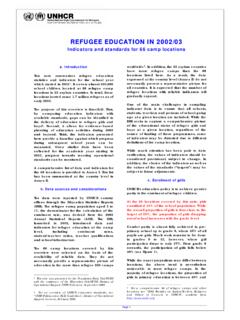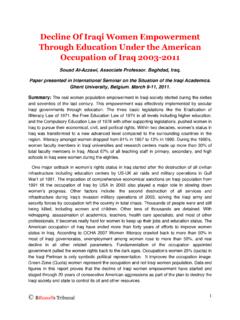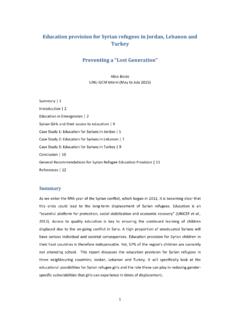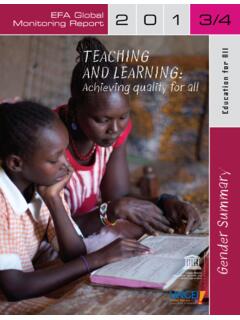Transcription of IRAQ - data.unicef.org
1 STATISTICAL PROFILE ON FEMALE GENITAL MUTILATION/CUTTINGF emale genital mutilation/cutting (FGM/C) refers to all procedures involving partial or total removal of the female external genitalia or other injury to the female genital organs for non-medical reasons. More than 125 million girls and women alive today have been cut in the 29 countries in Africa and the Middle East where FGM/C is concentrated. As many as 30 million girls are at risk of being cut before their 15th birthday if current trends continue. FGM/C is a violation of girls and women s human rights and is condemned by many international treaties and conventions, as well as by national legislation in many countries.
2 Yet, where it is practised FGM/C is performed in line with tradition and social norms to ensure that girls are socially accepted and marriageable, and to uphold their status and honour and that of the entire family. UNICEF works with government and civil society partners towards the elimination of FGM/C in countries where it is still practised. 1. World Health Organization, Eliminating Female Genital Mutilation: An interagency statement, WHO, UNFPA, UNICEF, UNIFEM, OHCHR, UNHCR, UNECA, UNESCO, UNDP, UNAIDS, WHO, Geneva, 2008, p. 4. 1 SELECTED STATISTICS ON WOMEN S STATUS DIVISION OF POLICY AND STRATEGYG uinea iraq Source.
3 MICS 201124%5%of women 20-24 years were married or in union before age 15of women 20-24 years were married or in union before age 1812%of women 20-24 years have given birthby age 1851%of women 15-49 years think that a husband/partner is justified in hittingor beating his wife under certain circumstances53%of women 15-49 years in union currently using any contraceptive method2011 National decree/legislation banning FGM/C passed in Kurdistan Region Data and Analytics Section UNICEF/NYHQ1991-1259/Isaac14 3 4 2 10 2 1 4 1 0 10 20 30 40 50 Total Urban Rural No education Primary complete Secondaryand higherKoranic/Non-standardPoorest Richest 8 6 9 10 4 0 10 20 30 40 50 Total Rural Urban Poorest Richest In iraq , the practice of FGM/C is concentrated in a few northern regionsApproximately half of girls and women underwent FMG/C after age 5, but for one in four women it is unclear at what age the practice occurredHOW WIDESPREAD IS THE PRACTICE?
4 WHEN AND HOW IS FGM/C PERFORMED? P15-49 years who have at least one daughter who has had FGM/C, by place of residence and mother's educationPercentage distribution of most recently cut daughters, by daughter's age at cutting Percentage of girls and women aged 15-49 yearswho have had FGM/C, by pr fecturePercentage of girls and women aged 15 to 49 years who have undergone FGM/C, by governatePercentage of girls and women aged 15 to 49 years who have undergone FGM/C, by residence and household wealth quintilePercentage of ever-married girls and women aged 15 to 49 years with at least one living daughter who has undergone FGM/C, by residence, mother's education and household wealth quintileDaughters whose mothers think FGM/C should continuePercentage distribution of girls and women aged 15 to 49 years who have undergone FGM/C, by age at which cutting occurred0 20 40 60 80 100 Percentage distribution of ever-married girls and women aged 15 to 49 years with at least one living daughter who has undergone FGM/C.
5 According to the type of person/practitioner performing the procedure27020406080100 HOW WIDESPREAD IS THE PRACTICE?WHEN AND HOW IS FGM/C PERFORMED? Daughters whosemothers areunsureDaughters whosemothers think FGM/C should stop0-4 years5-9 years10-14 years402615+ yearsDon t know/Missing160 20 40 60 80 100 664815 TraditionalpractitionerHealth personnelDon t know/Missing2529 51610% - 25%26% - 50%51% - 80%Less than 10%Above 80%Notes: The boundaries and the names shown and the designations used on the map do not imply official endorsement or acceptance by the United Nations. Only categories with 25 or more unweighted cases are presented.
6 Due to rounding, some of the data presented may not add up to 100 per cent. There is no ethnicity or religion data for iraq . Health personnel includes doctors, nurses, midwives and other health workers; Traditional practitioner refers to traditional (unlicensed) birth attendant/grandmother ; Other refers to the combined categories other and relative/friend . Source for all charts on this page: MICS 2011 Other0 Among daughters of cut girls and women, the percentage of those who have undergone FGM/C, by mothers attitudes about whether the practice should continue Percentage of girls and women aged 15 to 49 years who have undergone FGM/C, by current agePercentage of girls and women aged 15 to 49 years who have heard about FGM/C, by their attitudes about whether the practice should continueAlmost all girls and women in iraq think that FGM/C should stopSource for all charts on this page: MICS 2011 Note.
7 There are no ethnicity data for of girls and women aged 15 to 49 years who have heard about FGM/C and think the practice should continue, by household wealth quintile, education , residence and ageIn Erbil, the region with the highest FGM/C prevalence, the percentage of girls and women aged 15 to 49 years who have undergone FGM/C, by current ageIn Erbil, the region with the highest level of FGM/C, the prevalence has dropped significantly over timeWHAT ARE THE PREVAILING ATTITUDES TOWARDS FGM/C?IS THE PRACTICE OF FGM/C CHANGING? 70 69 67 58 59 55 43 0 20 40 60 80 100 45-49 40-44 35-39 30-34 25-29 20-24 15-19 5 13 1 17 6 2 5 9 4 7 4 0 10203040 50 Total Poorest Richest No education Primary complete Secondary or higher Koranic/non-standard curriculum Rural Urban 45-49 years 15-19 years 10 9 10 9 9 8 5 0 10 20 30 40 50 45-49 40-44 35-39 30-34 25-29 20-24 15-19 8858 Think FGM/C should continue Think FGM/C should stop Say it depends/are not sure 0 100 20 40 60 80 INTER-COUNTRY STATISTICAL OVERVIEWIRAQ1 2 2 3 5 6 7 9 9 10 11 14 17 21 31 34 37 38 41 41 42 45 49 54 64 65 66 69 73 Benin Togo Ghana Niger iraq
8 Cameroon Uganda Burkina Faso Kenya C te d'Ivoire Senegal Nigeria Ethiopia Guinea-Bissau Djibouti Chad Mauritania Yemen Sudan Liberia Eritrea Egypt Gambia Somalia Sierra Leone Guinea Mali 1 1 2 4 4 8 13 15 17 24 26 27 27 38 44 50 66 69 74 76 76 88 88 89 89 91 93 96 98 0 20 40 60 80 100 Cameroon Uganda Niger Ghana Togo iraq Benin Yemen Central African Republic Senegal Nigeria Kenya C te d'Ivoire Chad Guinea-Bissau Liberia Mauritania Ethiopia Burkina Faso Gambia Sudan Sierra Leone Mali Eritrea Egypt Djibouti Guinea Somalia n - Division of Policy and Strategy UNICEF, 3 UN Plaza, New York, 10017 Website: Email: MORE INFORMATION United Republic of Tanzania 0 20 40 60 80 100 Central African Republic United Republic of Tanzania Released December 2013 These country profiles were made possible through core funding to UNICEFand financial assistance of the European Union.
9 The contents of these country profiles are the sole responsibility of UNICEF and can in no way reflect the viewsof the European Union. The Data and Analytics Section gratefully acknowledges inputs shared by UNICEF country and Analytics SectioPercentage of girls and women aged 15 to 49 years with at least one living daughter who has undergone FGM/CPercentage of girls and women aged 15 to 49 years who have heard about FGM/C and think the practice should continuePercentage of girls and women aged 15 to 49 years who have undergone FGM/CNotes: Data on attitudes for Yemen refer to ever-married girls and women.
10 In Liberia, girls and women who have heard of the Sande society were asked whether they were members; this provides indirect information on FGM/C since it is performed during initiation into the society. Data on daughters for iraq refer to ever-married girls and women with at least one daughter who has undergone FGM/C. Data on attitudes for Ghana are from MICS 2006, for Nigeria from DHS 2008, and for Sierra Leone from DHS 2008 as data from the most recently available MICS surveys are not comparable. In Liberia, only cutgirls and women were asked about their attitudes towards FGM/C; since girls and women from practising communities are more likely to support the practice, the level of support in this country as captured by the DHS 2007 is higher than would be anticipated had all girls and women been asked their opinion.
